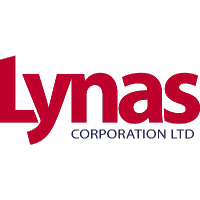Company Analysis Lynas Rare Earths Limited
1. Summary
Advantages
- The stock's return over the last year (115.04%) is higher than the sector average (-46.96%).
- Current debt level 6.57% is below 100% and has decreased over 5 years from 21.96%.
Disadvantages
- Price (9.72 $) is higher than fair price (0.6721 $)
- Dividends (0%) are below the sector average (5.8%).
- The company's current efficiency (ROE=3.84%) is lower than the sector average (ROE=9.69%)
Similar companies
2. Share price and performance
2.1. Share price
2.3. Market efficiency
| Lynas Rare Earths Limited | Materials | Index | |
|---|---|---|---|
| 7 days | 4% | 8.3% | 2% |
| 90 days | 60.1% | -47.4% | 9.8% |
| 1 year | 115% | -47% | 17.3% |
LYSCF vs Sector: Lynas Rare Earths Limited has outperformed the "Materials" sector by 162% over the past year.
LYSCF vs Market: Lynas Rare Earths Limited has outperformed the market by 97.73% over the past year.
Stable price: LYSCF is not significantly more volatile than the rest of the market on "OTC" over the last 3 months, with typical variations of +/- 5% per week.
Long period: LYSCF with weekly volatility of 2.21% over the past year.
3. Summary of the report
4. Fundamental Analysis
4.1. Stock price and price forecast
Above fair price: The current price (9.72 $) is higher than the fair price (0.6721 $).
Price is higher than fair: The current price (9.72 $) is 93.1% higher than the fair price.
4.2. P/E
P/E vs Sector: The company's P/E (65.69) is lower than that of the sector as a whole (158.36).
P/E vs Market: The company's P/E (65.69) is higher than that of the market as a whole (46.13).
4.2.1 P/E Similar companies
4.3. P/BV
P/BV vs Sector: The company's P/BV (2.48) is lower than that of the sector as a whole (2.82).
P/BV vs Market: The company's P/BV (2.48) is lower than that of the market as a whole (4.36).
4.3.1 P/BV Similar companies
4.4. P/S
P/S vs Sector: The company's P/S indicator (11.95) is higher than that of the sector as a whole (5.73).
P/S vs Market: The company's P/S indicator (11.95) is lower than that of the market as a whole (12.96).
4.4.1 P/S Similar companies
4.5. EV/Ebitda
EV/Ebitda vs Sector: The company's EV/Ebitda (30.45) is lower than that of the sector as a whole (42.75).
EV/Ebitda vs Market: The company's EV/Ebitda (30.45) is higher than that of the market as a whole (27.25).
5. Profitability
5.1. Profitability and revenue
5.2. Earnings per share - EPS
5.3. Past profitability Net Income
Yield Trend: Negative and has fallen by -77.79% over the last 5 years.
Accelerating profitability: The return for the last year (0%) exceeds the average return for 5 years (-77.79%).
Profitability vs Sector: The return for the last year (0%) exceeds the return for the sector (-5.18%).
5.4. ROE
ROE vs Sector: The company's ROE (3.84%) is lower than that of the sector as a whole (9.69%).
ROE vs Market: The company's ROE (3.84%) is lower than that of the market as a whole (52.17%).
5.5. ROA
ROA vs Sector: The company's ROA (3.11%) is lower than that of the sector as a whole (5.07%).
ROA vs Market: The company's ROA (3.11%) is lower than that of the market as a whole (36.33%).
5.6. ROIC
ROIC vs Sector: The company's ROIC (22.18%) is higher than that of the sector as a whole (14.73%).
ROIC vs Market: The company's ROIC (22.18%) is higher than that of the market as a whole (10.84%).
7. Dividends
7.1. Dividend yield vs Market
Low yield: The dividend yield of the company 0% is below the average for the sector '5.8%.
7.2. Stability and increase in payments
Unstable dividends: The company's dividend yield 0% has not been consistently paid over the past 7 years, DSI=0.
Weak dividend growth: The company's dividend yield 0% has been growing weakly or stagnant over the past 5 years. Growth over only 0 years.
7.3. Payout percentage
Dividend Coverage: Current payments from income (0%) are at an uncomfortable level.
Pay for your subscription
More functionality and data for company and portfolio analysis is available by subscription

 MAX Chat
MAX Chat



